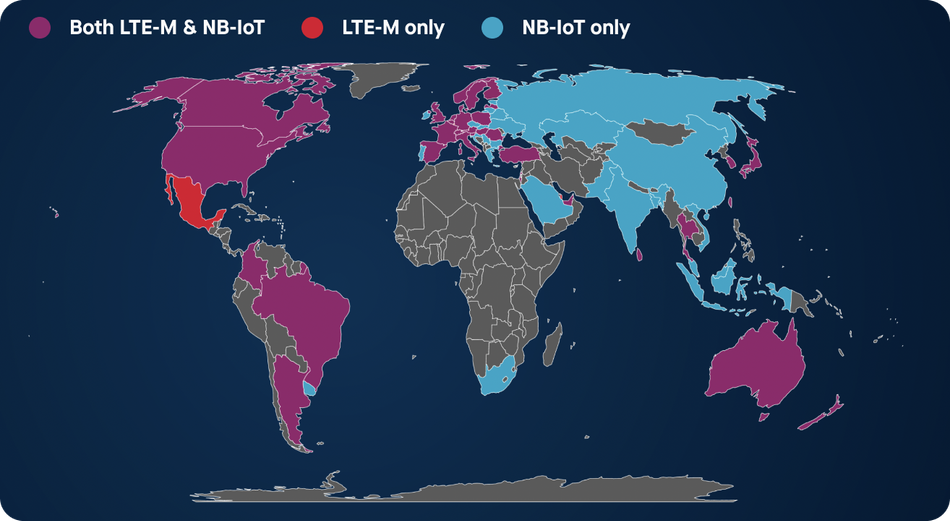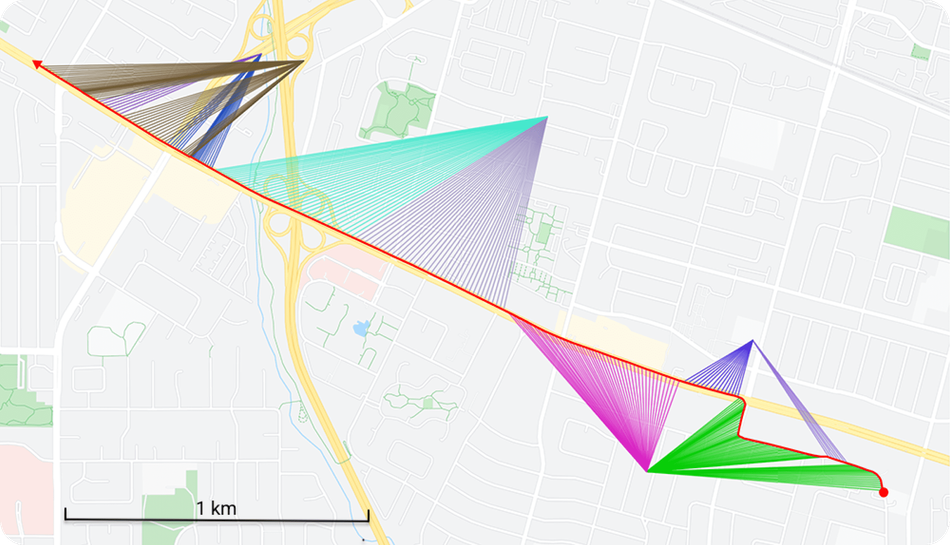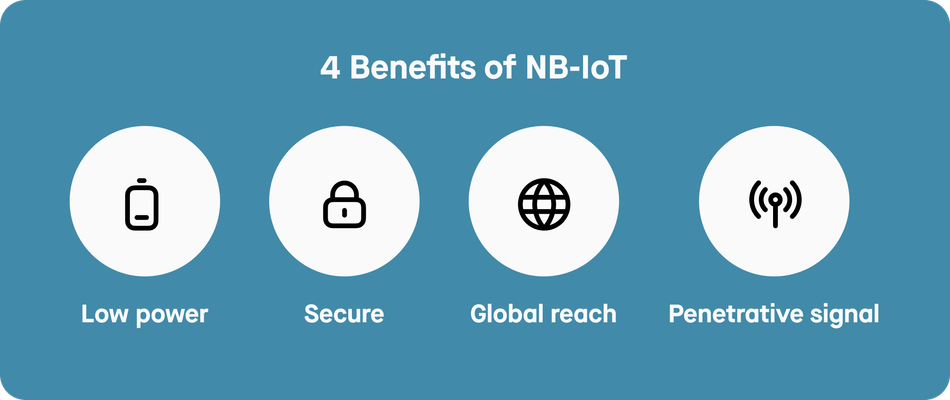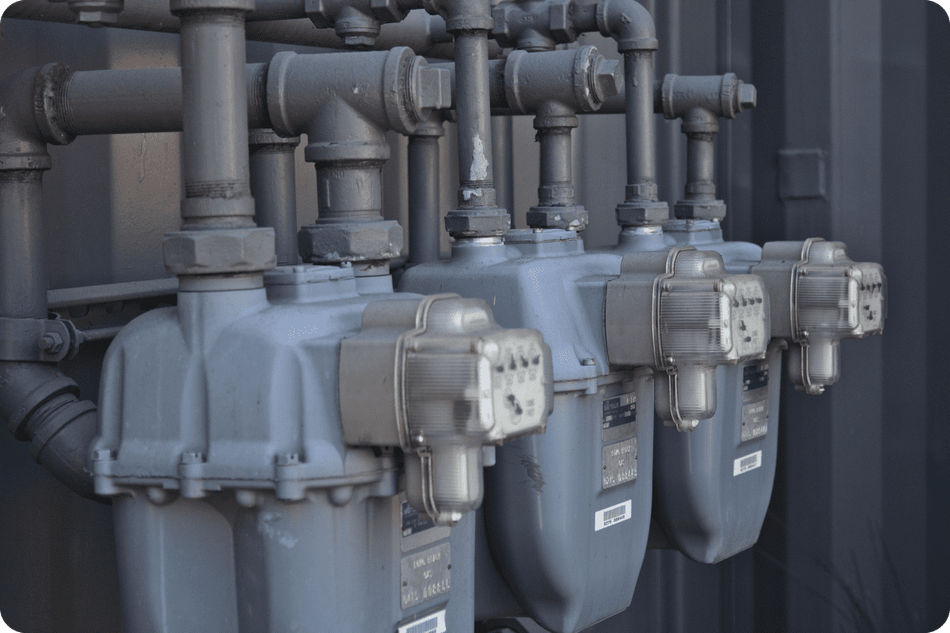Understanding Narrowband IoT (NB-IoT): Benefits, Applications, and Limitations
In this article, we will expand on the features of cellular narrowband IoT, or NB-IoT, and how it differs from other cellular technologies such as LTE-M.
This article was first published on
akenza.ioIoT is a fast-growing sector that is transforming businesses. However, its rapid growth means there are many connectivity technologies to play with, and sometimes it is hard to understand their differences and particularities. In this article, we will expand on the features of cellular narrowband IoT, or NB-IoT, and how it differs from other cellular technologies such as LTE-M.
What is NB-IoT?
NB-IoT is a low-power wide-area network (LPWAN) technology used by devices to communicate to IoT cloud applications via the cellular network. It communicates via GSM and LTE networks. This technology is best suited for uses that exchange little amounts of data over extended periods. Devices operating on NB-IoT typically run on batteries and consume very little power. NB-IoT offers enhanced signal ranges, making it ideal for supporting use cases in areas with limited coverage, such as underground and in buildings.
NB-IoT and LTE-M are both cellular technologies below the LPWAN umbrella, supporting a wide range of IoT use cases. So what is the best connectivity choice to take advantage of this technology?
The choice is based on the use case and how you plan to utilize the data. We will examine the key distinctions between these two cellular technologies.
What is the difference between NB-IoT and LTE-M?
3rd Generation Partnership Project (3GPP) defines both NB-IoT and LTE-M protocols, which support deployments with long lifespans and low bandwidth and operate in licensed spectrums. However, a few factors clearly distinguish them from one another. Depending on your application, these elements are essential to take into account.
Deployment
3GPP characterizes both NB-IoT and LTE-M part of 5G. While LTE-M is compatible with the current 4G network, NB-IoT may be implemented on 2G (GSM) and 4G (LTE) networks. The GSMA has developed a map to illustrate the global deployment of NB-IoT and LTE-M.

Usually, upgrading existing LTE towers is more straightforward than adding NB-IoT. However, installing new NB-IoT infrastructure is less expensive if LTE is unavailable.
Mobility
There is a clear divide regarding mobility between the two technologies. When a device is in motion, it switches cell towers frequently. LTE-M is able to handle these transitions smoothly, which make it a good candidate for IoT cases involving moving devices. Until recently, NB-IoT was not handling the transfer between base stations as smoothly. Once the device leaves the coverage area and becomes disconnected, it must reconnect to the network, weakening the connection and increasing power consumption. However, with the new 3GPP Release 14, NB-IoT connected devices can move from one station to another without needing a new connection.

Cost
If price is a deciding factor, NB-IoT could be a better option. LTE-M users have to pay royalties because carriers own the underlying patents. Moreover, if the network is deployed as a standalone network, the cost of deploying an NB-IoT network may be lower than an LTE-M network, as it requires fewer resources and has a simpler network architecture.
Data rates
NB-IoT is focused on very low data rates as it is limited in data bandwidth, constrained to a 180kHz narrowband vs. LTE-M, having one of the highest bandwidth of the 3GPP LPWAN standard at 1.4 MHz. LTE-M is specialized in transferring low to medium amounts of data, up to 1 Mbps, compared to 66 kbps for NB-IoT (159 kbps LTE Cat NB2). As LTE-M can exchange more data than NB-IoT, it is better for applications requiring a larger data exchange at a lower latency such as real-time monitoring, remote control and video surveillance.
Use cases
NB-IoT is most suited for static applications like smart city facilities management, smart farming, waste containers, metering applications, car park sensors, and temperature and humidity sensors. LTE-M can work for static and mobile use cases such as asset monitoring, allowing a seamless base station handover.
Benefits to NB-IoT
LTE-M and NB-IoT technology both have their benefits. If you are considering NB-IoT for your solution, we will look into a few of the perks of using this technology:
Power efficient and economical
Can you picture having to replace the batteries in billions of devices annually? In the IoT world, sustained battery life is crucial. With its small energy consumption and power saving mode (PSM) when it is not checking for incoming data, sensors using NB-IoT technology have an average battery life of 10+ years. Consuming less power means cost savings.
Security
NB-IoT offers every security measure that mobile networks cover, such as secure authentication, signaling protection, and data encryption. Additionally, NB-IoT uses a licensed cellular spectrum.
Broader use and global reach
As previously mentioned, NB-IoT can coexist with 2G, 3G, and 4G networks. NB-IoT has low bit rates and can connect sensors directly to the base station without needing a gateway. It has the additional benefit of securing many connections per base station. NB-IoT supports cell ranges up to 10km and offers a 20-decibel link budget, increasing coverage even in areas with previously poor coverage. This increases the deployment flexibility of NB-IoT.
Penetrative signal
NB-IoT’s low bit rate frequency enables connectivity in areas where signals would otherwise be unreachable. As a result, it is the superior technology for use underground and in other confined places.
NB-IoT applications
NB-IoT applications can span a wide range of use cases. We will touch on a few and why NB-IoT best supports each case:
Smart metering and smart building
Sensors for electricity, water, or gas meters are typically located in basements. They do not require large amounts of data, making them perfect use cases for NB-IoT. Sensors commonly found in smart buildings, such as temperature, pressure, humidity, and pollution, are typically located in basements and enclosed spaces.
Smart city
As more and more people are moving to urban areas, the future of cities is changing to accommodate this influx. There is a greater need for proper waste management, clean drinking water, and better urban planning. NB-IoT helps to minimize these challenges that become more prominent with higher population density.
Asset tracking
With its long battery life and licensed cellular spectrum, NB-IoT is a reliable and secure technology communication for asset tracking. It is best used for tracking static assets rather than mobile assets.
Limitations to NB-IoT
NB-IoT technology is not perfect for each use case. It is crucial to consider the limitations to make an informed decision based on your project needs.
Limited data transmission
As mentioned previously, NB-IoT is designed for low data transfer rates. This can limit the types of applications that can be supported by NB-IoT. Typically, these applications don’t support voice or video. In comparison to other technologies, the data downlink rate is also much lower at about 26kbps.
Limited device mobility
NB-IoT is optimized for stationary or slow-moving IoT devices, such as smart meters, environmental sensors, or certain asset trackers. It is not designed to support high-speed or highly-mobile devices. Moreover, it is limited in terms of handover and roaming capabilities. As mentioned above, this issue is being addressed by the new release of 3GPP.
NB-IoT and the future
Suppose your project is likely to have sensors in remote locations, requires long battery life, and does not need high bandwidth to transfer large amounts of data. In that case, NB-IoT might be the right choice for your application. With an increasing number of connected devices globally, we can expect many more to support this technology in the future. The akenza platform can support you on your project, managing connectivity, devices, and data in one place to provide real-time results and data visualization.
Are you ready for your next IoT project? Request a demo here.


